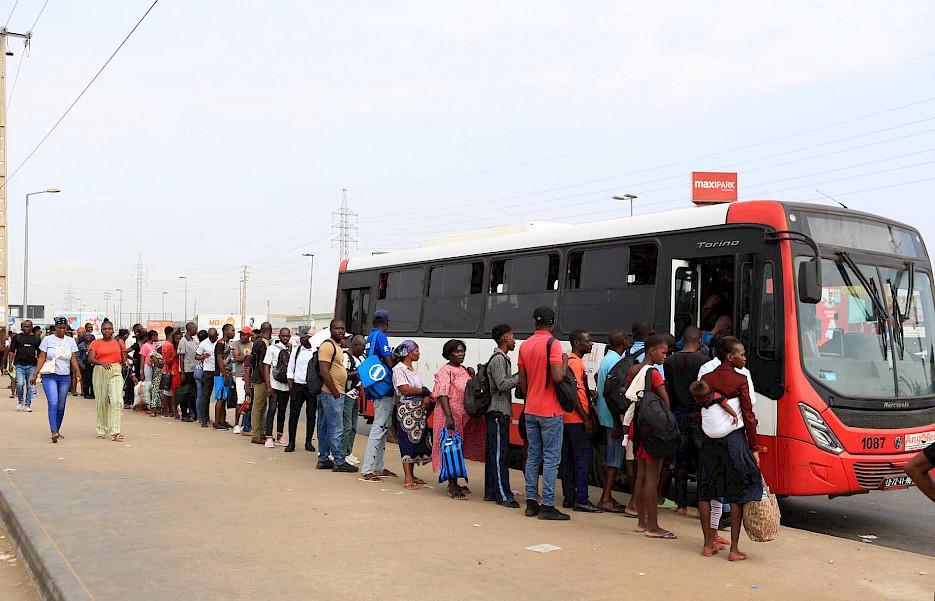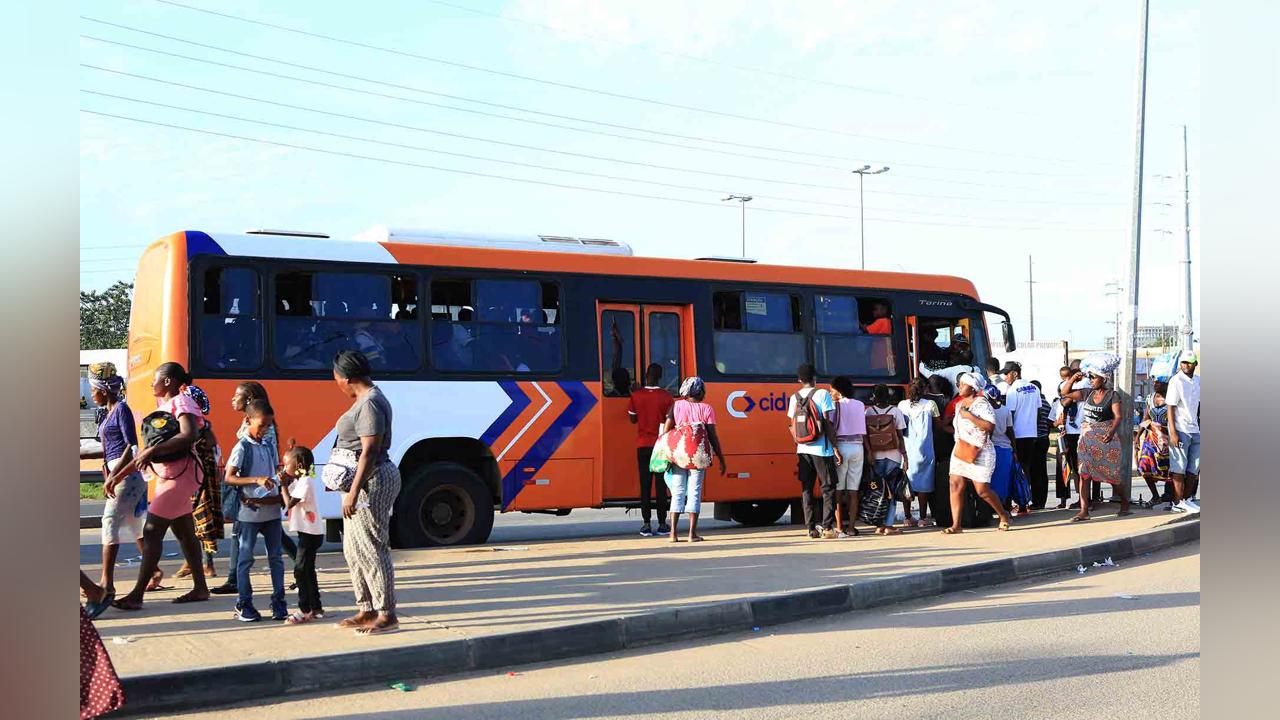Africa-Press – Angola. The province of Luanda will have, by the end of the year, a special public urban transport service, to assist passengers during the night and early morning, assured the provincial director of Transport, Traffic and Mobility of the country’s capital, Filipe Cumandala.
This service, as part of improvements in traffic and mobility in the country’s capital, will be provided by the nine companies operating in Luanda and will operate from 10 pm to 6 am.
In an interview, the director said that the main objective is to extend the opening hours of the buses and facilitate citizens/passengers who are distressed or need to circulate in this sensitive period.
According to the official, each operator will provide a bus for this period, within the same territory (the routes of the normal career) awarded to it, under the acquired license.

Technically, explains the director, the buses will follow a path that will take them to universities, hospitals, police units, passenger terminals, among other institutions, with a waiting time of no more than one hour.
To this end, the Provincial Government of Luanda (GPL), operators and the National Police are working to create the best technical and security conditions for the start of operations.
For example, one of the major constraints presented by operators is related to issues related to safety at stops, along the journey and public lighting.
“There is no precise date, but operations will start as soon as the conditions are created, however, the data indicate for this year”, he asserted.
Asked about the problem of urban public transport in Luanda, which results in floods, long queues, excessive waiting times and overcrowding, the director considered that the solution to the problem cannot be solved only by increasing the fleet of buses.

In the manager’s view, around 92% of Angolans (27 million inhabitants) use the national transport system every day.
This projection, explains the official, indicates that there is a great demand for urban and suburban transport to transport people and goods across the country and therefore there is an urgent need to improve secondary and tertiary roads.
For this reason, says the official, the Angolan government has been betting on DMU (Diesel Motor Unit) trains, catamarans and on the construction of the surface metro, since Luanda has more than 10 million inhabitants.
As an example, the composition of a DMU (with five carriages) transports more than 700 passengers in one trip, which corresponds to more than 20 taxis (Hiace square) and about 12 stander buses.
Likewise, they contribute to the improvement of urban mobility in the capital, security and public lighting, number and quality of stops, as well as the extension of routes to the interior of the municipalities, as well as the increase in the fleet of buses.
According to the provincial director of Transport, Traffic and Mobility of the capital of Luanda, Filipe Cumandala, the capital is served by nine operators and they operate in the nine municipalities of Luanda, in a promotion by the Ministry of Transport.
For technical reasons, adds the official, the capital is served daily by only 400 buses, of the 572 available, transporting an average of five thousand passengers daily, per operator.
This fact occurs because these buses are still new and are in warranty period and when they go for periodic maintenance, at the dealerships, it takes an average of three to six months, removing them from circulation.
On the other hand, it is necessary to invest in infrastructure, such as primary, secondary and tertiary roads, in order to make means available inside the localities and better serve passengers.
Also, he pointed out, it is necessary to stagger the bus schedules, the space between the departure and the destination point, setting a commercial speed and an exclusive lane for the buses.
Regarding the long queues and floods that occur at the stops, the director understands that they result, in part, from the organization of passengers, in queues, which currently occurs at the stops, as well as due to the migration of many taxis to buses, with a view to reducing costs.
“Currently there is more organization at the stops, creating long queues, a fact that conveys the illusion of heavy flooding at the stops, as, in the past, it was a struggle to get on the buses. Yesterday, this scenario is behind us”, illustrated the person in charge.
With regard to stops, the Government of the province of Luanda will soon start building and improving passenger shelters (stops).
Passengers clamor for service improvements
Passengers from the province of Luanda who spend 50 kwanzas per trip to travel from home to work, school and to the most different destinations, claim greater humanization in urban public transport services.
Among the main complaints, the creation of passenger terminals, waiting times, lack of connectivity, long queues, overcrowding, stop conditions, as well as the small number of buses in circulation.
Likewise, passengers are calling for the need to rehabilitate secondary and tertiary roads to allow transport to get closer to the population and the consequent increase in routes and frequencies.
Josimar Baptista, 47 years old, resident of Bairro do Prenda, Urban District of Maianga, and worker for a company in Bairro Kapalanga, municipality of Viana, believes that if passenger terminals were built in each district or municipality, it would help a lot for the proper functioning of urban mobility in Luanda.
“Daily, we lose between two and three hours in the process of boarding and disembarking, during the coming and going, a fact that has negatively influenced health, production and quality of work performance.
I start the service at 8 am, but I have to get up at five to be at the stop in Largo das Escolas at 6 am. I leave at 5 pm, I face a long line of more than 500 meters, standing up, my legs ache with tiredness, due to the more than two hours of waiting”, he asserted.
In the same vein, Filomeno Kizembe, a resident of Viana, laments the fact that he has to travel around two kilometers every day to catch the bus, endangering his physical integrity, due to the objective of reaching his workplace.
The students, in the afternoon, Celso Gaspar, Elizabeth Marques and Hamilton Manuel, residents of the municipalities of Cazenga and Viana, respectively, say that to get to school on time, they need to leave home two to three hours in advance. .
“We left the house around 10 am, we couldn’t do our homework anymore, not even our schoolwork, because we had to hurry, because we had a long time to board and also the traffic jam”, argued the young people.
Citizen Helena Ginga, a domestic worker, regrets the waiting time, the long queues and the lack of conditions at the stops.
“ It’s a pain to catch a bus, especially at the end of the journey, a person is standing for at least two hours. It is necessary to increase the fleet of buses to Luanda”, he lamented the constraints.
The operators

The province of Luanda has nine operators, TCUL, Macon, AngoReal, Angoaustral, Impala Express, Cidrália, Rosalina Express and Gira Express, to transport the more than 10 million citizens of the country’s capital.
The nine companies cover the nine municipalities of Luanda province, on 75 routes, from 5:30 am to 8 pm, every day of the week, using the single urban fare of 50 kwanzas for each journey.
In an interview, the commercial and marketing director of Impala Express, Giesen Kayiranga, said it was necessary for the authorities to resolve the constraints pointed out by passengers, with the aim of mitigating the difficulties that passengers and companies face.
“If the Government overcomes these problems, passengers will have a waiting time of less than 15 minutes, in the interval between one and another bus and the extension of our schedules”, understands the official.
According to the manager, the poor condition of the roads, especially in periods of rain, causes enormous wear and tear on the means and high costs for replacing materials, which are also scarce in the national market.
“There is not always immediate availability of replacement material from concessionaires, a fact that prolongs the resumption of bus operations, so we are forced to resort to the parallel market or direct import of spare parts”, he said.
On the other hand, he made it known that Impala Express has benefited from some support from the Government, such as, for example, of the 14 buses they own, nine were transferred, in resolvable income, by the State.
However, according to the manager, the company, with its own capital, acquired seven more buses, which will arrive by June of this year, to reinforce the fleet and expand the operating routes.
For More News And Analysis About Angola Follow Africa-Press






